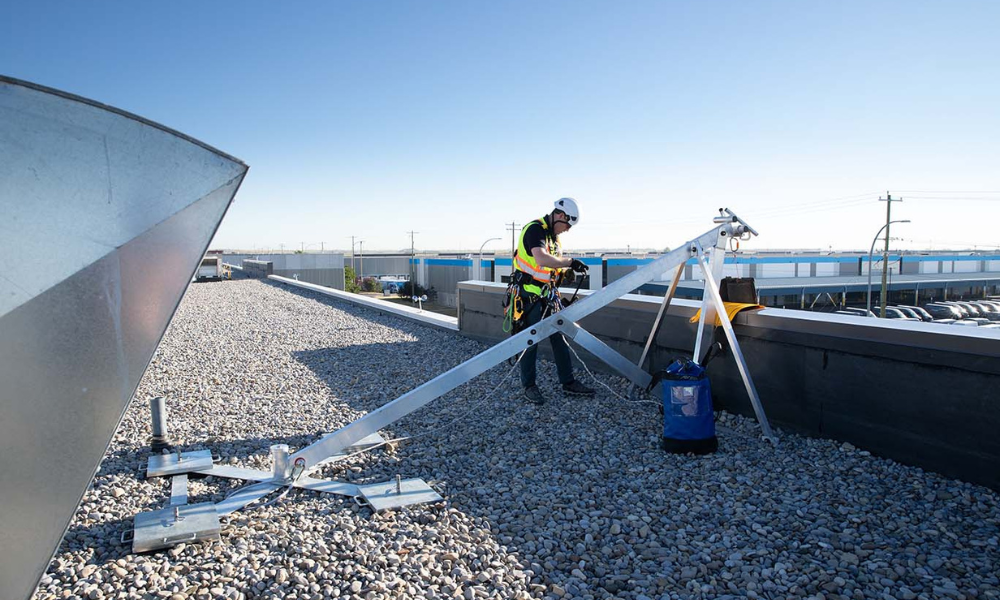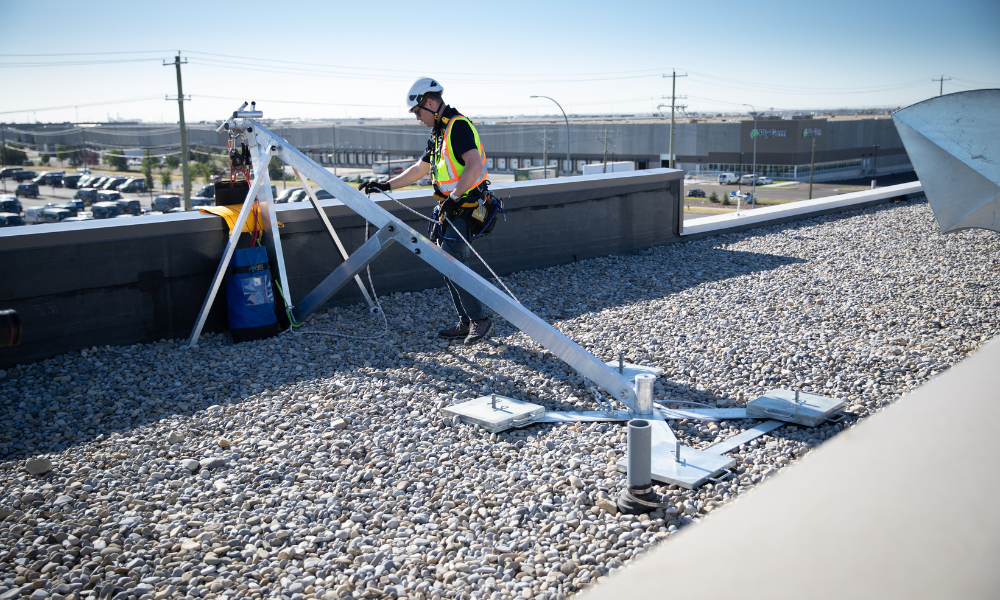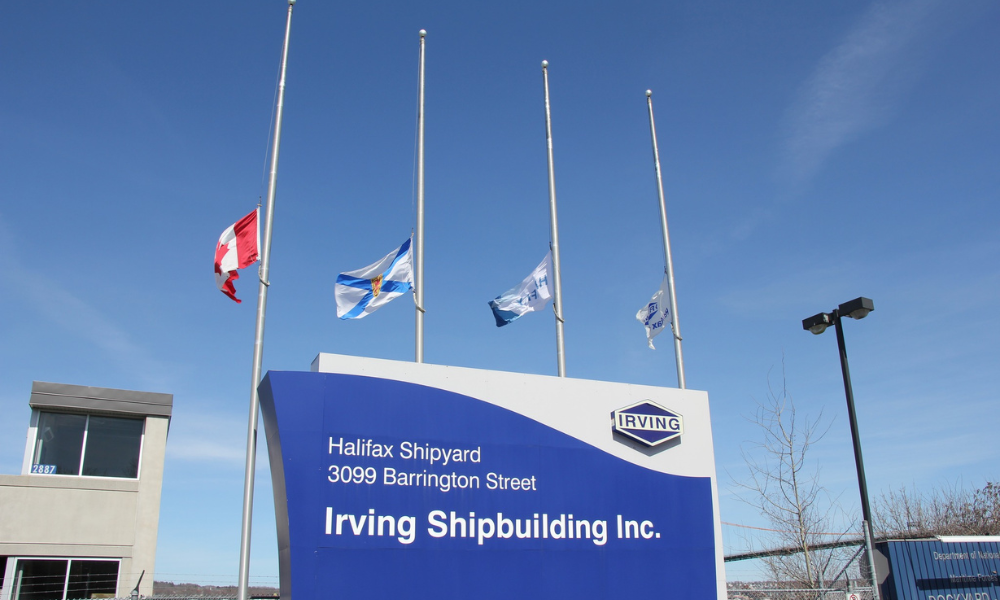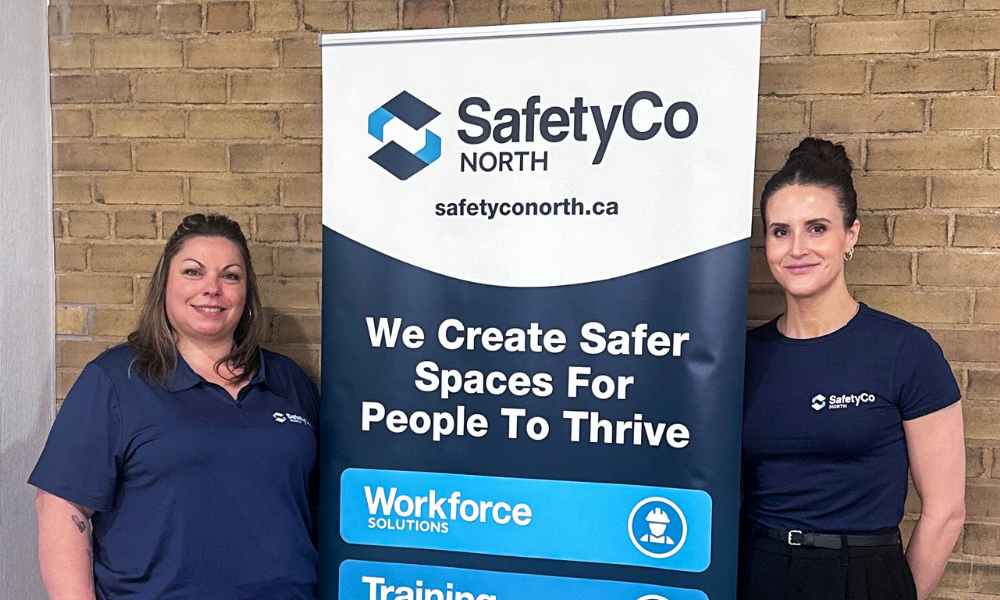A comprehensive suite of lifelines and anchors to fit any building, budget, or business

This article was produced in partnership with Kee Safety.
While an injury in any capacity is something to guard against, when it comes to working from heights, a slip and fall from an unprotected roof edge can be catastrophic. Workers who access a facility’s roof, whether it be for inspections, maintenance, repairs, or another purpose, should be leveraging a horizontal lifeline system and anchor combination to catch them when it counts.
Kee Safety offers a wide range of engineered lifelines that can be used for fall arrest and fall restraint protection when attached to anchors and safety eyebolts, and these solutions are well-received by the end users. But time and again, the Kee Safety team was hearing the same story from clients: we only do window washing once or twice a year, so why spend thousands of dollars for permanent roof anchors? Taking that feedback onboard, Nick Bixcul, strategic solutions manager at Kee Safety, thought to himself, there must be another way.
“Most people don’t want to do new construction on a building unless they really have to, and we understand that,” he says. “I have a trademark saying — ‘Impossible is two letters too long’ — and I believe there’s nothing that can’t be done. You just have to think about it differently.”
The new Kee Attach Mobile Rope Access
With the goal of performing rope access or suspension work off the edge of a building without penetrating the building itself, the Kee Safety team got to work. The Kee Safety Team of engineers and fall protections specialists developed the Kee Attach Mobile Rope Access, a non-penetrative anchor point that let’s users complete a job many thought could only be done via permanent anchors.
Kee Safety was able to develop a sensible solution that checks the box of getting work completed but in a way that’s better, safer, and more efficient — and it proves Bixcul’s long-held belief that limitations are only of the mind.
“We think about safety and client needs, putting it all together to give the best options,” he says. “I tell people not to be limited by what you think is possible, speak to others. Think outside the box. The options are endless.”
Kee Safety’s Lifeline & Anchor solutions
Kee Attach joins Kee Safety’s comprehensive line of horizontal lifelines and roof anchors, all of which are backed by Kee Safety’s experts. With national, provincial, and territorial standards require roof anchors to be used with lifeline systems, or “active” fall protection equipment, knowing and understanding those regulations is critical. It’s also important to determine which type of roof anchor suits the facility and activity best.
One of Kee Safety’s solutions is a permanent roof anchor, Kee Post, for those who have the volume of activity — or the budget — to permanently install a straightforward solution that secures workers to the building’s structure. From supporting suspended platforms to providing direct fall protection and integrating with horizontal lifelines, Kee Post’s functionality is designed to be flexible. It works on multiple roof types and allows for multiple connection types, making it a popular option.
For clients who prefer more flexibility of location, there’s Kee Anchor, a mobile, deadweight anchor device for use on roofs where the installation of collective protection or a permanent anchor device isn’t feasible. Highly versatile and engineered with additional friction that reduces any movement during a fall arrest event, Kee Anchor is an easy to use and adaptable solution.

Kee Line, a flexible, cost-effective option for working at height, is configured for use on multiple roof types and can accommodate buildings of various shapes. At its maximum span, it allows up to three users at a time and is corrosion resistant, ensuring longevity. Kee Safety’s trained and certified installers work with clients to create the ideal configuration for their needs. There’s also Kee Track, a rigid rail overhead track system that offers a wide range of mounting options that can be adapted at any point to a rearranged working environment. Ideal for users working at short free-fall distances — carrying out operations on trains, trucks, and aircraft with low ground clearances, for example — the lightweight trolley with sealed bearings allows complete hands-free movement.
For Bixcul, who joined Kee Safety over a decade ago, bringing to market a variety of options along with the expertise to help clients choose the best route for them and their business is critical.
“I work strategically with various organizations and government bodies to identify issues and find not just solutions, but a solution that make the most sense for them.”
Separating people from hazards
Kee Safety’s driving force is to separate people from hazards and offering a variety of solutions that serve that purpose — as well as developing new and innovative products such as Kee Attach — is part and parcel of that mission. But the products on their own are not enough, Bixcul cautions, adding that if you think of sports equipment, it’s only as good as the person using it. A depth of understanding is needed to be effective, and that’s where training comes in.
Kee Safety’s Calgary training facility is state of the art, from the building itself to the courses it provides and the instructors that run them. The people who work there have been in the industry many years, take their jobs seriously, and understand the risks. They also grasp how essential it is to have comprehensive training and strive to make sure everyone who crosses the threshold leaves knowing how to operate the equipment properly, its limitations, and the critical safety procedures that ensure they get home safely at the end of the day.

For anchor bolt and lifeline installation and testing specifically, hands-on professional training couldn’t be more critical. Workers need to be prepared with the necessary skills to install and maintain fall protection systems and equipment, which reduces the chance of a system failure, accident, or injury. Training also ensures compliance with regulations, avoiding penalties and liabiltty, and it reflects well on the company. Bolstering credibility and a commitment to a culture of safety, these courses also inspire confidence for employees who work at height — a significant benefit that can’t be understated, Bixcul notes, adding that while he’s been to many training operations throughout his career, he can confidently say he stands behind the one Kee Safety has developed.
“Our people know there are lives at risk and that’s a heavy responsibility,” he says. “We take it very seriously.”
Ultimately, Bixcul says the coming together of good ideas and good engineers truly can make those seemingly impossible ideas work, and that’s what Kee Safety is all about. The Kee Attach is the latest in a long line of innovation, it works well, and if you have any questions about it or anything else safety-related? Reach out. For any of their solutions, the Kee Safety team provides comprehensive support and guidance at every stage, from installation and certification to training.
“It’s not just words we say at Kee Safety, it’s how we approach situations: developing real-life solutions for real-life problems,” Bixcul sums up. “Come talk to us, and we’ll help you the best way we can.”





